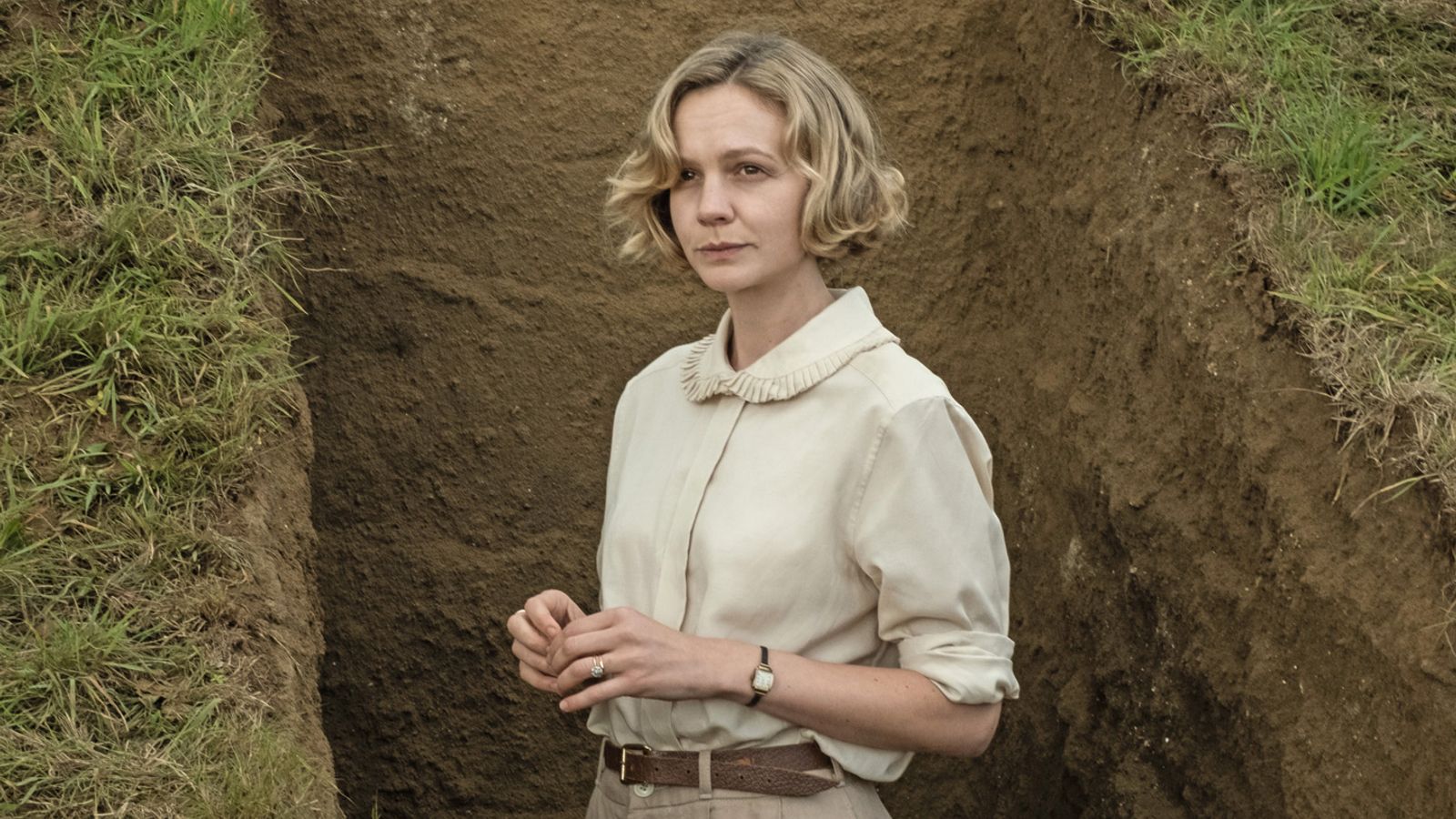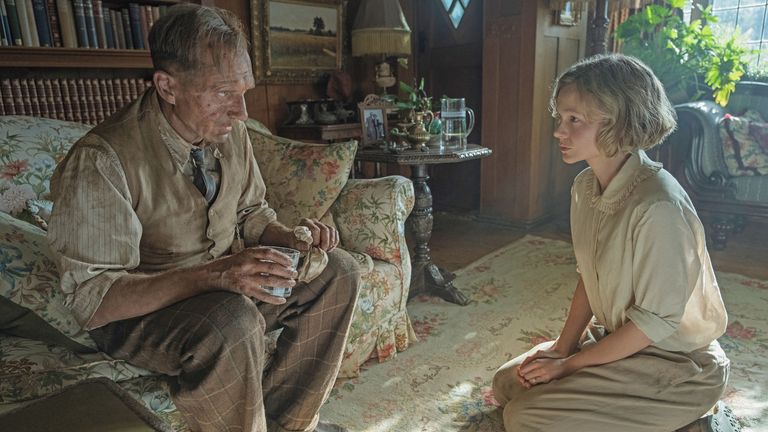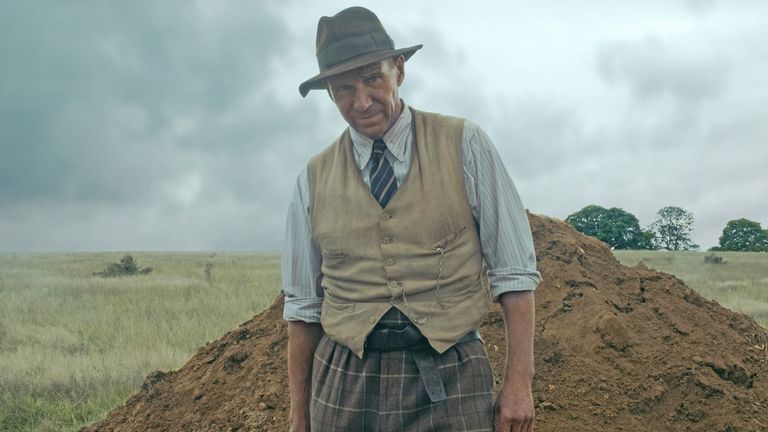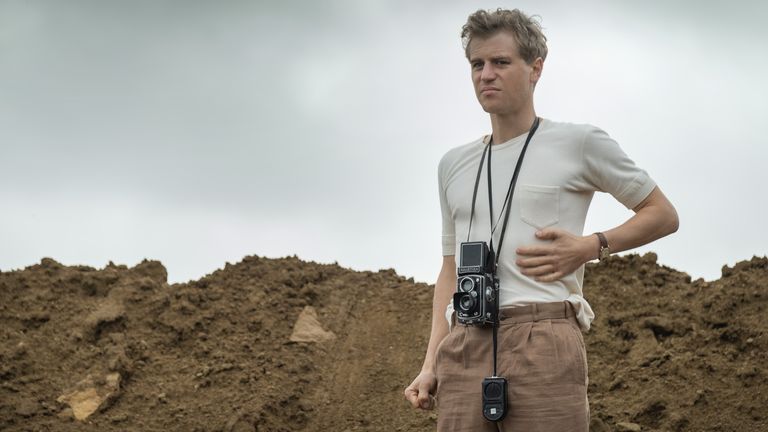When I suggest to the director of The Dig that a film about archaeology isn’t usual blockbuster fare, he quite rightly reminds me that “Lara Croft and Indiana Jones were pretty big box office hits”.
Simon Stone has a point – and while digging a hole and poking about in the mud may not seem action-packed – the lure of buried treasure and hidden mysteries from the past does have a unique attraction.
And for those that don’t know their Sutton Hoo history, the real-life discovery of an Anglo-Saxon ghost ship filled with riches, weaponry and armour in Sussex back in 1939 was a fairly big deal.
So much so in fact, that unlike most movies, this one doesn’t call on its male and female leads – Carey Mulligan playing wealthy estate owner Edith Pretty and Ralph Fiennes as self-taught archaeologist Basil Brown – to be romantically involved to keep audience interest alive.
As Mulligan tells Sky News: “It’s very rare that you see a woman and a man on screen in terms of title roles where they’re not a couple. We don’t see that kind of friendship between men and women on screen very much – there’s always some sort of romantic angle.”
As a leading lady, Edith Pretty is also a refreshing portrayal of an older woman, not afraid to go against the flow.
As Mulligan explains: “She married very late. She was 42 because she refused her husband’s offers of proposal for so long because she was caring for her father, who was very ill.
“And she didn’t have a kid until she was 47, and then four years later, her husband died. So, she had a huge amount of tragedy and I think just having somebody that she felt understood her [Basil Brown] was really, really special.”
Despite falling in love with the role, by her own admission Mulligan happened upon it in an “unconventional way”, stepping in at the last minute to replace Nicole Kidman after a scheduling conflict led the Australian star to pull out.
Director Stone says Mulligan’s casting ended up being a happy accident: “[Nicole] had to drop out and Carey came in to save the day… And she came in and she transformed everything.”
Subscribe to the Backstage podcast on Apple Podcasts, Google Podcasts, Spotify, Spreaker
Praising the “honour and soul” she brought to the role of a woman living as the head of the household in the late 1930s, he labels Mulligan’s performance “utterly transfixing”.
And it wasn’t just the chance to play a more unconventional part that tempted Mulligan to sign up – the prospect of working with actor Ralph Fiennes also helped seal the deal.
Fittingly, Fiennes himself was born in Suffolk, not a million miles from the location of the Sutton Hoo discovery site.
With a father who farmed the land in the 1950s, the actor went to both nursery and primary school in the county, and now as an adult has a holiday cottage in the area.
Like Mulligan, he found the chance to play a character with more on their mind than romance intriguing.
He told Sky News: “What moved me was that Edith and Basil connect because of a shared interest. And I think her asking him to dinner is not a romantic move, it’s because he has a mind and is a person who she is interested in as a human on an equal level.”
Fiennes even got to learn a bit about archaeology in the role, as well as reading through Brown’s own handwritten diary of dig notes and recreating the 30-mile bike ride the archaeologist would have completed between his home and the discovery site every other weekend.
While the issue of class is raised in the film (as a working-class labourer Brown was swiftly dismissed from heading up the excavation the moment its historical importance was realised), Fiennes says he doesn’t think the workman was necessarily discriminated against.
He explains: “I think the archaeological establishment moved in, and they probably nodded and said, ‘Thank you, you’ve done great work. Now could you please do the wheelbarrow?’
“But I’m sure they did respect his work… It was wartime, and this thing was big, and in the adrenaline of it all, I can see how [him being dismissed as the project lead] would have been upsetting. But I would be uneasy to say he had been treated with contempt.”
Fiennes admits however that there was one major failing at the time – Brown was left out of the history books and archaeological accounts when it came to recording the find.
That’s a wrong that has since been righted, with Brown’s name now appearing alongside that of Pretty’s in the British Museum’s permanent display of the treasure.
As Fiennes says, now: “In archaeological lore or to any archaeologist who knows about the research, they all will look at Basil Brown as a heroic example of expert excavating.”
While both actors clearly relished their roles, Mulligan does admit “it wasn’t the most glamorous set”, with the majority of the film taking place in a muddy field in Guildford in mid-November 2019.
Set at the outbreak of World War II, the movie also reinforces the communal spirit that comes into play in times of difficulty – something that Mulligan says is more relevant than ever as the country battles against the coronavirus pandemic.
The actress explains: “[COVID-19] isn’t a war, but there’s this massive fear in society at the moment and trepidation, and the way people have largely come together through that does echo the way we’ve dealt with big crises in the past.
“I think there’s something quite affirming about that. When we’re all put to the test in difficult times we come together as a community – that’s certainly been my experience.”
The Dig is streaming on Netflix from 29 January.





